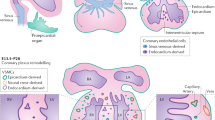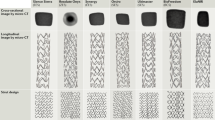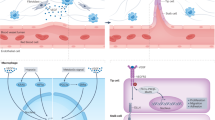Key Points
-
The development of drugs capable of stimulating revascularization of underperfused tissues remains an exciting but unrealized goal in cardiovascular medicine.
-
Recently, much has been learned about the process of new vessel growth and enlargement, the characteristics of agents that might generate new blood vessels in patients, and the nature of clinical investigations that could show efficacy and safety of this novel class of medications.
-
This review first summarizes the current state of clinical experience, and then discusses three principal issues that need to be resolved:
-
First, the identification of agents that promote growth and remodelling of larger vessels (arteriogenesis) rather than smaller vessels (true angiogenesis);
-
Second, the establishment of the required length of drug exposure in vivo and optimal means of drug delivery;
-
Third, the selection of patients, clinical trial end-points and indications for these agents.
Abstract
Despite considerable progress in the management of ischaemic cardiovascular disease during the past three decades, there remains a significant population of patients who are not served well by current treatment approaches. Stimulating revascularization in ischaemic regions is an attractive novel therapeutic strategy, and several angiogenic agents anticipated to have the potential to achieve this goal have been clinically evaluated in recent years. However, as yet none have shown sufficient efficacy to be approved. Here, we consider the key findings from the completed clinical trials of therapeutic angiogenesis in cardiovascular disease, and discuss possible changes to the way in which such agents are developed that could improve the chances of success.
This is a preview of subscription content, access via your institution
Access options
Subscribe to this journal
Receive 12 print issues and online access
$209.00 per year
only $17.42 per issue
Buy this article
- Purchase on Springer Link
- Instant access to full article PDF
Prices may be subject to local taxes which are calculated during checkout



Similar content being viewed by others
References
Henry, T. D. et al. The VIVA trial: Vascular endothelial growth factor in Ischemia for Vascular Angiogenesis. Circulation 107, 1359–1365 (2003).
Simons, M. et al. Pharmacological treatment of coronary artery disease with recombinant fibroblast growth factor-2: double-blind, randomized, controlled clinical trial. Circulation 105, 788–793 (2002).
Laham, R. J. et al. Local perivascular delivery of basic fibroblast growth factor in patients undergoing coronary bypass surgery: results of a phase I randomized, double-blind, placebo-controlled trial. Circulation 100, 1865–1871 (1999).
Ruel, M. et al. Long-term effects of surgical angiogenic therapy with fibroblast growth factor 2 protein. J. Thorac. Cardiovasc. Surg. 124, 28–34 (2002).
Lederman, R. J. et al. Therapeutic angiogenesis with recombinant fibroblast growth factor-2 for intermittent claudication (the TRAFFIC study): a randomised trial. Lancet 359, 2053–2058 (2002).
Grines, C. L. et al. Angiogenic gene therapy (AGENT) trial in patients with stable angina pectoris. Circulation 105, 1291–1297 (2002).
Losordo, D. W. et al. Phase 1/2 placebo-controlled, double-blind, dose-escalating trial of myocardial vascular endothelial growth factor 2 gene transfer by catheter delivery in patients with chronic myocardial ischemia. Circulation 105, 2012–2018 (2002).
Hedman, M. et al. Safety and feasibility of catheter-based local intracoronary vascular endothelial growth factor gene transfer in the prevention of postangioplasty and in-stent restenosis and in the treatment of chronic myocardial ischemia: phase II results of the Kuopio Angiogenesis Trial (KAT). Circulation 107, 2677–2683 (2003).
Jiang, C. et al. Gene expression profiles in human cardiac cells subjected to hypoxia or expressing a hybrid form of HIF-1α. Physiol. Genomics 8, 23–32 (2002).
Jeong, J. W. et al. Regulation and destabilization of HIF-1α by ARD1-mediated acetylation. Cell 111, 709–720 (2002).
Pugh, C. W. & Ratcliffe, P. J. Regulation of angiogenesis by hypoxia: role of the HIF system. Nature Med. 9, 677–684 (2003).
Fang, J., Yan, L., Shing, Y. & Moses, M. A. HIF-1α-mediated up-regulation of vascular endothelial growth factor, independent of basic fibroblast growth factor, is important in the switch to the angiogenic phenotype during early tumorigenesis. Cancer Res. 61, 5731–5735 (2001).
Ulleras, E., Wilcock, A., Miller, S. J. & Franklin, G. C. The sequential activation and repression of the human PDGF-B gene during chronic hypoxia reveals antagonistic roles for the depletion of oxygen and glucose. Growth Factors 19, 233–245 (2001).
Li, J., Shworak, N. W. & Simons, M. Increased responsiveness of hypoxic endothelial cells to FGF2 is mediated by HIF-1α-dependent regulation of enzymes involved in synthesis of heparan sulfate FGF2-binding sites. J. Cell Sci. 115, 1951–1959 (2002).
Schaper, W. & Ito, W. Molecular mechanisms of collateral vessel growth. Circ. Res. 79, 911–919 (1996).
Helisch, A. & Schaper, W. Arteriogenesis: the development and growth of collateral arteries. Microcirculation 10, 83–97 (2003). A current and comprehensive review of arteriogenesis.
Dor, Y. et al. Conditional switching of VEGF provides new insights into adult neovascularization and pro-angiogenic therapy. EMBO J. 21, 1939–1947 (2002). This important study suggests that a prolonged course of growth-factor expression might be required to stabilize and preserve newly formed vasculature.
Lopez, J. et al. Hemodynamic effects of intracoronary VEGF delivery: evidence of tachyphylaxis and NO dependence of response. Am. J. Physiol. 273, H1317–H1323 (1997).
Sato, K. et al. Efficacy of intracoronary or intravenous VEGF165 in a pig model of chronic myocardial ischemia. J. Am. Coll. Cardiol. 37, 616–623 (2001).
Vincent, K. A. et al. Angiogenesis is induced in a rabbit model of hindlimb ischemia by naked DNA encoding an HIF-1α/VP16 hybrid transcription factor. Circulation 102, 2255–2261 (2000).
Ware, J. A. & Simons, M. Angiogenesis in ischemic heart disease. Nature Med. 3, 158–164 (1997).
Ito, W. D. et al. Monocyte chemotactic protein-1 increases collateral and peripheral conductance after femoral artery occlusion. Circ. Res. 80, 829–837 (1997).
Arras, M. et al. Monocyte activation in angiogenesis and collateral growth in the rabbit hindlimb. J. Clin. Invest. 101, 40–50 (1998).
van Royen, N. et al. Effects of local MCP-1 protein therapy on the development of the collateral circulation and atherosclerosis in Watanabe hyperlipidemic rabbits. Cardiovasc. Res. 57, 178–185 (2003).
Voskuil, M. et al. Modulation of collateral artery growth in a porcine hindlimb ligation model using MCP-1. Am. J. Physiol. Heart Circ. Physiol. 284, H1422–H1428 (2003).
Heil, M. et al. Blood monocyte concentration is critical for enhancement of collateral artery growth. Am. J. Physiol. Heart Circ. Physiol. 283, H2411–H2419 (2002).
Rafii, S. & Lyden, D. Therapeutic stem and progenitor cell transplantation for organ vascularization and regeneration. Nature Med. 9, 702–712 (2003).
Terada, N. et al. Bone marrow cells adopt the phenotype of other cells by spontaneous cell fusion. Nature 416, 542–545 (2002).
Ying, Q. L., Nichols, J., Evans, E. P. & Smith, A. G. Changing potency by spontaneous fusion. Nature 416, 545–548 (2002).
Fuchs, S. et al. Transendocardial delivery of autologous bone marrow enhances collateral perfusion and regional function in pigs with chronic experimental myocardial ischemia. J. Am. Coll. Cardiol. 37, 1726–1732 (2001).
Kocher, A. A. et al. Neovascularization of ischemic myocardium by human bone-marrow-derived angioblasts prevents cardiomyocyte apoptosis, reduces remodeling and improves cardiac function. Nature Med. 7, 430–436 (2001).
Assmus, B. et al. Transplantation of Progenitor Cells and Regeneration Enhancement in Acute Myocardial Infarction (TOPCARE-AMI). Circulation 106, 3009–3017 (2002).
Tse, H. F. et al. Angiogenesis in ischaemic myocardium by intramyocardial autologous bone marrow mononuclear cell implantation. Lancet 361, 47–49 (2003).
Stamm, C. et al. Autologous bone-marrow stem-cell transplantation for myocardial regeneration. Lancet 361, 45–46 (2003).
Tomita, N., Morishita, R., Higaki, J. & Ogihara, T. Novel molecular therapeutic approach to cardiovascular disease based on hepatocyte growth factor. J. Atheroscler. Thromb. 7, 1–7 (2000).
Li, J. et al. PR39, a peptide regulator of angiogenesis. Nature Med. 6, 49–55 (2000).
Luttun, A. et al. Revascularization of ischemic tissues by PlGF treatment, and inhibition of tumor angiogenesis, arthritis and atherosclerosis by anti-Flt1. Nature Med. 8, 831–840 (2002).
Cao, R. et al. Angiogenic synergism, vascular stability and improvement of hind-limb ischemia by a combination of PDGF-BB and FGF-2. Nature Med. 9, 604–613 (2003). Demonstration of functional synergy between the two growth factors in several model settings.
Khurana, R. & Simons, M. Insights from angiogenesis trials using fibroblast growth factor for advanced arteriosclerotic disease. Trends Cardiovasc. Med. 13, 116–122 (2003).
Post, M. J., Laham, R., Sellke, F. W. & Simons, M. Therapeutic angiogenesis in cardiology using protein formulations. Cardiovasc. Res. 49, 522–531 (2001).
Hughes, G. C., Post, M. J., Simons, M. & Annex, B. H. Translational physiology: porcine models of human coronary artery disease: implications for preclinical trials of therapeutic angiogenesis. J. Appl. Physiol. 94, 1689–1701 (2003).
Simons, M. Therapeutic coronary angiogenesis: a fronte praecipitium a tergo lupi? Am. J. Physiol. 280, H1923–H1927 (2001).
Laham, R. J. et al. Intracoronary and intravenous administration of basic fibroblast growth factor: myocardial and tissue distribution. Drug Metab. Dispos. 27, 821–826 (1999).
Muhlhauser, J. et al. Safety and efficacy of in vivo gene transfer into the porcine heart with replication-deficient, recombinant adenovirus vectors. Gene Ther. 3, 145–153 (1996).
Wright, M. J., Wightman, L. M., Latchman, D. S. & Marber, M. S. In vivo myocardial gene transfer: optimization and evaluation of intracoronary gene delivery in vivo. Gene Ther. 8, 1833–1839 (2001).
Wright, M. J. et al. In vivo myocardial gene transfer: optimization, evaluation and direct comparison of gene transfer vectors. Basic Res. Cardiol. 96, 227–236 (2001).
Nevo, N. et al. Increasing endothelial cell permeability improves the efficiency of myocyte adenoviral vector infection. J. Gene Med. 3, 42–50 (2001).
Grossman, P. M., Han, Z., Palasis, M., Barry, J. J. & Lederman, R. J. Incomplete retention after direct myocardial injection. Catheter Cardiovasc. Interv. 55, 392–397 (2002).
Communal, C. et al. Decreased efficiency of adenovirus-mediated gene transfer in aging cardiomyocytes. Circulation 107, 1170–1175 (2003).
March, K. L. et al. Efficient in vivo catheter-based pericardial gene transfer mediated by adenoviral vectors. Clin Cardiol. 22, 123–129 (1999).
Gerber, T. C. et al. The coronary venous system: an alternate portal to the myocardium for diagnostic and therapeutic procedures in invasive cardiology. Curr. Interv. Cardiol. Rep. 2, 27–37 (2000).
Schultz, A. et al. Interindividual heterogeneity in the hypoxic regulation of VEGF: significance for the development of the coronary artery collateral circulation. Circulation 100, 547–552 (1999).
Matsunaga, T. et al. Angiostatin inhibits coronary angiogenesis during impaired production of nitric oxide. Circulation 105, 2185–2191 (2002).
Simons, M. et al. Clinical trials in coronary angiogenesis: issues, problems, consensus: An expert panel summary. Circulation 102, E73–E86 (2000). A comprehensive discussion of clinical trial issues in the field of therapeutic angiogenesis.
Dougherty, C. M., Dewhurst, T., Nichol, W. P. & Spertus, J. Comparison of three quality of life instruments in stable angina pectoris: Seattle Angina Questionnaire, Short Form Health Survey (SF- 36), and Quality of Life Index-Cardiac Version III. J. Clin. Epidemiol. 51, 569–575 (1998).
Richardson, R. S. et al. Human VEGF gene expression in skeletal muscle: effect of acute normoxic and hypoxic exercise. Am. J. Physiol. 277, H2247–H2252 (1999).
Jones, M. K. et al. Inhibition of angiogenesis by nonsteroidal anti-inflammatory drugs: insight into mechanisms and implications for cancer growth and ulcer healing. Nature Med. 5, 1418–1423 (1999).
Masferrer, J. L., Koki, A. & Seibert, K. COX-2 inhibitors. A new class of antiangiogenic agents. Ann. NY Acad. Sci. 889, 84–86 (1999).
Harada, K. et al. Vascular endothelial growth factor administration in chronic myocardial ischemia. Am. J. Physiol. 270, H1791–H1802 (1996).
Post, M. J. & Simons, M. in Topol's Textbook of Interventional Cardiology 4th edn (ed Topol, E. J.) 757–779 (W. B. Saunders, Philadelphia, 2003).
Author information
Authors and Affiliations
Corresponding author
Related links
Related links
DATABASES
LocusLink
FURTHER INFORMATION
Encyclopedia of Life Sciences
Glossary
- CLAUDICATION
-
A condition in which cramping pain in the leg is induced by exercise, typically as a result of obstruction of the arteries.
- ANGIOPLASTY
-
Catheter-based repair or unblocking of a blood vessel, such as a coronary artery.
- RESTENOSIS
-
A re-narrowing or blockage of an artery at the same site where treatment, such as an angioplasty, has already been performed.
Rights and permissions
About this article
Cite this article
Simons, M., Ware, J. Therapeutic angiogenesis in cardiovascular disease. Nat Rev Drug Discov 2, 863–872 (2003). https://doi.org/10.1038/nrd1226
Issue Date:
DOI: https://doi.org/10.1038/nrd1226
This article is cited by
-
Transmembrane stem factor nanodiscs enhanced revascularization in a hind limb ischemia model in diabetic, hyperlipidemic rabbits
Scientific Reports (2024)
-
Stem cell therapy combined with controlled release of growth factors for the treatment of sphincter dysfunction
Cell & Bioscience (2023)
-
Angiogenic content of microparticles in patients with diabetes and coronary artery disease predicts networks of endothelial dysfunction
Cardiovascular Diabetology (2022)
-
Application of stem cell-derived exosomes in ischemic diseases: opportunity and limitations
Journal of Translational Medicine (2021)
-
Injectable pre-cultured tissue modules catalyze the formation of extensive functional microvasculature in vivo
Scientific Reports (2020)



